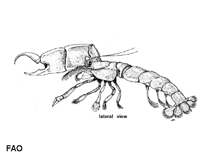| Family: |
Callianassidae (ghost shrimp) |
| Max. size: |
max. reported age: 2 years |
| Environment: |
benthic; brackish; marine |
| Distribution: |
Indo-West Pacific: Australia. |
| Diagnosis: |
Rostrum a short, blunt and wide triangle, far overreached by the squarish eyes (almost with their full length). No antennal spine, but antennal angle low, broad and rounded. Antennular peduncle reaching with more than half the length of the third segment beyond the antennal peduncle. Third maxilliped with merus and ischium strongly widened, forming an operculum; distal three segments all narrow, each three times or more longer than wide. Large chela in adult male with deep concavity in the anterior margin of the palm just above the base of the fixed finger. Carpus about as long as the palm and slightly longer than high. Merus with a large, curved, bluntly rounded lobe in the basal part of the lower margin. Telson quadrangular, longer than wide with broadly rounded posterolateral angels, without spines. Endopod or uropod broadly oval, only slightly longer than telson (Ref. 4). |
| Biology: |
It has a total body length of 1.5 to 6 cm (Ref. 4). It is found on intertidal sand or mud flats, often in or near estuaries. They burrow in the soft substratum (Ref. 4). |
| IUCN Red List Status: |
Not Evaluated (N.E.) Ref. 123251)
|
| Threat to humans: |
|
| Country info: |
|
Source and more info: www.sealifebase.org. For personal, classroom, and other internal use only. Not for publication.

